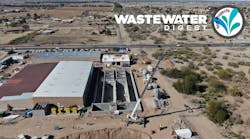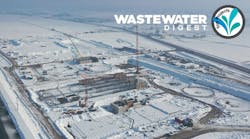Cost: $5.6 million
Location: Eastvale, Pa.
Year: 2010-12-01
Size: 11.0 mgd
Owner: Beaver Falls Municipal Authority
Designers: KLH Engineers Inc.
Contractor: Marucci & Gaffney Excavating Pipeline Systems Inc.; Wagner Electric Construction
The Eastvale, Pa., Water Treatment Plant’s new raw water intake was a long time coming: The existing raw water intake structure was more than a century old, and it was designed for a different purpose than it was being used for in modern times. The water system has grown to a point where it now serves close to 50,000 people in 23 communities.
“It’s a rather large regional system, and as the system grew through the past century, they were basically stuck with this one existing intake and they finally got to the point where it was such a burden and a maintenance headache,” said James S. Willard, P.E., project manager, of KLH Engineers Inc. “The problems were such that they oftentimes could not maintain adequate production at the facility.” Prior to the start of construction, the project team spent close to a year doing extensive planning. They looked at rainy wells and riverbend designs. They considered the concept of intake structures further out in the Beaver River, along with different types of screens. Willard described the process as a “matrix” in terms of certainly meeting the primary function of having an adequate volume intake that was capable of removing the debris in the river, yet also taking into account maintenance considerations and capital and operating costs.“The basic screen that we settled on was a dual-flow traveling band screen,” Willard said. “But another one of the factors that came into play with it was meeting the EPA 316B fish protection requirements.”This gave the team an added benefit of creating a stilling basin leading into the screens, which provided enhanced settlement. The improved settlement led to another one of the design concepts—to create hopper-bottomed intakes in both the primary intake chamber and the emergency intake chamber to allow them to draw out settled solids from the bottom of the basin and return them to the river. Construction of the new intake, which went live in the fall of 2010, was accomplished by installation of a circular sheet pile coffer dam. The dewatering of that and establishment of the dry hole to work in was the most challenging aspect of the project, team members agreed. “You open up books about water treatment plant design and you go to the section about designing a raw water intake—there are so many variables that are based upon the needs and upon the environment where you’re designing for. This is about as pure design as civil engineering gets,” said Rob Horvat, design engineer with KLH. “Particularly in the water/wastewater field, you have to take everything into consideration and there is no cookie-cutter template for a raw water intake, and it’s very rare to find two that are identical.”
Project Year: 2010-12-01
Contractor: Marucci & Gaffney Excavating Pipeline Systems Inc.; Wagner Electric Construction
Designers: KLH Engineers Inc.
Owner: Beaver Falls Municipal Authority
Location: Eastvale, Pa.
Cost: $5.6 million
Size: 11.0 mgd


